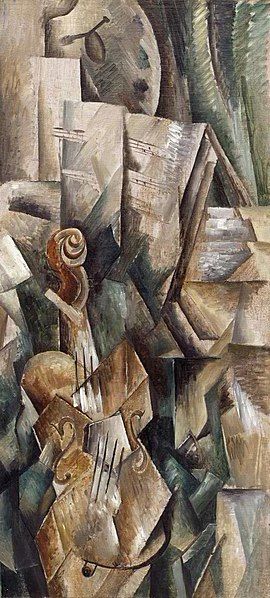Summary of Purism
A decade after Cubism rocked the art world with its deconstruction of subject matter into simple geometric shapes and interlocking planes, Edouard Jeanneret (known as the modern architect Le Corbusier) and Amédée Ozenfant tweaked its lexicon for use in French painting and architecture. They coined this fresh variant Purism, which at its most basic function, proposed a new kind of art in which objects were represented as powerful forms devoid of any extraneous detail. They published this stripped down theory in their 1918 book Après le Cubisme (After Cubism). As the movement formally developed in the period following World War I, it is also viewed as part of Interwar Classicism, a movement that emphasized classical principles as a "return to order" of social and cultural forces.
Key Ideas & Accomplishments
- Purism reduced subject matter to the relationships of its geometric angles and shapes, further emphasized through color toward a unified effect. These "pure" forms were composed of their intrinsic qualities and absent of any representational meaning. This infiltrated all aspects of the arts including painting, design, and architecture.
- Along with the burgeoning advent of technology and the machine age, Purist artists aimed to infuse mechanical and industrial subject matter with a timeless quality. This influenced work in which shapes were lent references to ancient, classical forms absent of decoration or additional ornamentation.
- The still life painting became a popular form of articulating Purist philosophies. In this genre, artists would take objet types, or reproducible everyday objects from their own environments, and reduce them to aesthetically pleasing, shapes and forms that emphasized the simple beauty of the modern world.
- Short lived, Purism climaxed at Le Corbusier's Pavillon de l'Esprit Nouveau (Pavilion of the New Spirit), built in 1925 for the International Exposition of Decorative and Industrial Arts in Paris (the exhibition was very large, and ironically, it was the birth of Art Deco movement). A perfect time capsule of the movement, the exhibition presented Le Corbusier, Ozenfant, Fernand Léger, alongside Cubists Juan Gris and Jacques Lipchitz, after which Ozenfant and Le Corbusier ended their partnership.
- Purism rejected the over-embellishment that was signature to the society's bourgeois notion of beauty at the time. The movement, and in particular Le Corbusier's advocacy for the simplification and modulation of form, would go on to influence generations of artists and architects interested in mass production and classical order in art, building, design, and even the construction of city plans.
Overview of Purism
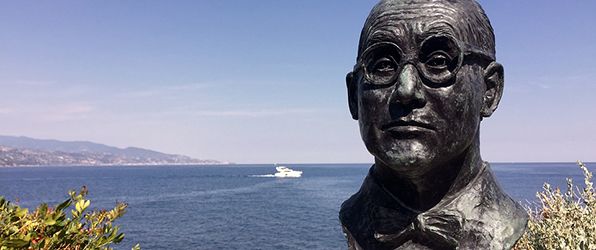
Le Corbusier, the founding father of Purism, is a contentious figure. He has been presented as both a "fascist-leaning ideologue whose plans for garden cities were inspired by totalitarian ideals, and a humanist who wanted to improve people's living conditions". Nevertheless, the art and architecture he created alongside Amédée Ozenfant was revolutionary.
Artworks and Artists of Purism

Still Life
This relatively early Purist work shows a number of objet types, including a string instrument, two bottles, a stack of white plates, and a funnel, arranged in an orderly composition to emphasize the solidity of the elementary forms. These objects, taken from the kitchen, the living room, and the building fixtures, are depicted without any extraneous detail to create a modern aesthetic that reflects both functionality and a rational environment. The architectonic influence is apparent in the columnar neck of the instrument and the arrangement of the plates, as the top plate, its white oval turned toward the viewer, resembles an industrial duct, an effect enhanced by the tubing in the lower center. As a result, the painting is unified by its architectural structure, as the background rectangles of walls and window are echoed by the plane of the foreground and the serene volume of a building block in the lower center of the canvas. The painting embodies what art historian Kenneth Frampton has called Purism's "iconic ethos." The objects become dignified, even stately, conveying the artist's view that the mass productions of the modern world were aesthetically beautiful.
The palette, as art critic Christopher Knight wrote is "also derived from Cubism...Line is elevated instead, in forms whose crispness is enhanced by sharp edges, clear curves, and clear planes of light. The life of the senses is superseded by the life of the mind." Le Corbusier's paintings have been primarily studied, Knight noted, as "theoretical excursions into territory that would find its most compelling expression in the built world of architecture."
Oil on canvas - The Museum of Modern Art, New York

Bottle and Fruit Bowl
This still life shows a number of objects, including a bottle, a glass, and a fruit bowl situated on a pedestal, arranged on the intersecting geometric planes of a table. Hues reflect the color palette of Synthetic Cubism with warm tones of red, yellow, and brown contrasting with cooler greens and blues. Employed in broad areas that are delineated as if they were cut outs, the color fields create a bold graphic effect that also suggests collage. Relationships between geometric angles and shapes take center stage, further emphasized by color. The vibrant interaction between the objects reflects the café as a locus of social interaction.
While not completely identified with the Purist movement, Gris' development of his Cubist works around 1920 and beyond led to his exhibiting with the movement. Simplifying Cubism's multiple fractured planes in favor of an emphasis on geometric planes, he began composing objects to a unified effect on a flattened pictorial plane. Ozenfant and Le Corbusier viewed his work as reflecting the Purist impulse in Cubism and as an important precursor that lent validity to their own movement. Accordingly, Gris' work was included in the Pavillon de l'Esprit Nouveau in 1925.
Oil on canvas - Kunstmuseum, Winterthur, Germany

Nature morte (Still Life)
This painting, emphasizing a few objects, a guitar's body, a musical instrument's neck, and three bottles against a background of grey, white, and nearly-black planes, reflects Purism's emphasis on the solidity and simplicity of formal elements. Unlike traditional still life, which often included plants, flowers, and organic forms, this work focuses on an entirely manufactured environment. The dark bottle and light glass in the foreground are shown in profile while their openings are shown from above, a Cubistic treatment transformed into Purism's emphasis on geometry in the repeating circles.
Ozenfant employs his distinctive architectural allusions, as art historian Kenneth Silver wrote, "although the extreme abstraction of Purist paintings - the compression of space, simplification of forms, implied transparencies - accounts for their 'modern look', a rather old-fashioned notion of hierarchies (specifically, Charles Blanc and André Michel's academic concept of architecture as the primary discipline from which the other arts descend) endows the paintings with their monumental sense of wholeness. Ozenfant's forms, particularly the fluted bottles and glasses he painted so often, begin to resemble Roman arcades and Doric columns." As a result, as Christopher Knight wrote, "Purism shifted the avant-garde orientation of Cubist painting toward the past - specifically toward the neoclassical tradition so prominent in French painting for 300 years." At the same time, aesthetic value is conferred upon these manufactured objects, as if they were a modernist equivalent of the classical ideal.
Oil on canvas - San Francisco Museum of Modern Art, San Francisco

Nature morte au verre de vin rouge (Still Life with Glass of Red Wine)
This still life depicting a guitar, a pitcher, bottles, a glass of red wine, a carafe, and several architectural motifs flattens and fills the pictorial plane, creating an orderly unification of foreground and background. The transparent forms overlap creating strong contours and silhouettes that emphasize the formal qualities of the objects rather than any play of light. The color palette is restrained, reflecting Purism's emphasis on structural form rather than decorative color, as Ozenfant strove for an effect of cool rationality. As art historian Lucy Flint noted, his approach "resulted in compositions that are lucid and geometric."
Purism's movement toward emphasizing the contours of volumetric shapes, becomes more emphasized here, as some of the objects overlap, with the result that they create new formal relationships with the geometric planes in front of and behind them.
Oil on canvas - Kunstmuseum, Basel, Switzerland
Three Women (Le Grand Déjeuner)
This work depicting three nudes, two of them in the reclining position of an odalisque, in a modern living room replete with ordinary objects, mechanizes and fragments the human figure in order to emphasize the interplay of geometric form. The artist's geometric order, created by a plethora of contrasts between rectangles, squares, circles, and triangles, conveys the dynamic stimulation of modern life, while his depiction of the human form takes on the cylindrical and conical volumes of modern industry. A sense of polished solidity is conveyed, a moment of geometric poise, as if the engine of modern life were caught in one fragmented instance.
In 1920 Léger's work began to reflect the influence of Purism, as he simplified the elements of his composition in favor of a geometric repose that reflected the era's "return to order." As art critic Christopher Knight wrote, he "saw in Purism something both intellectually profound and pragmatically useful for his material practice as a painter. It offered a relevant, exciting conceptual scaffolding." His figurative treatments, here revisiting a traditional subject of Western art, and his bold color palette were a unique contribution to Purism. This work contains elements of both Purist still life, as seen in the objects arranged on the small table, and architectural motifs, as seen in the industrial like cylinders and cones of the human figure, but translated into his unique and powerful idiom, as Knight noted of a 2001 exhibition of the three Purists, "Léger's paintings practically blow Ozenfant's and Corbusier's off the walls."
Oil on canvas - The Museum of Modern Art, New York
Mural Painting
This painting employs ascending red, blue, black, grey and white rectangles to emphasize the vertical energy of the pictorial plane. Most of the shapes are geometrically regular, while the exceptions - the contoured blue vertical on the right and the red vertical in the lower third of the painting - have a silhouette effect. At the same time, two blue rectangles create horizontal movement, reflecting what the artist called "the law of contrasts," so that the forms seem to overlap, receding or expanding in space.
Léger's use of strong color, and his movement toward abstraction were innovative contributions to Purism. Abandoning the mass-produced object, he turned to "pure colors and geometric forms," and envisioned them as monumental murals for public settings saying, "Abstraction requires large surfaces, walls. There one can organize an architecture and a rhythm." He showed his first mural paintings in the 1925 Pavillon de l'Esprit Nouveau. He would go on to create these types of "paintings in space" for such iconic buildings as the United Nations Headquarters in New York and private clients such as his fireplace piece for Nelson A. Rockeller.
Oil on canvas - The Solomon R. Guggenheim Museum, New York, New York
Beginnings of Purism
Amédée Ozenfant
In 1915 Amédée Ozenfant, who became the leading theorist and pioneer of Purism, founded the magazine L'Elan with Guillaume Apollinaire and Max Jacobs. While editing the magazine in the following year, he began formulating the concepts of Purism in articles including his 1916 essay "Notes sur le cubism,"(Notes on Cubism). He critiqued Cubism in a number of works, as art historian Kenneth Silver wrote, "The ways and means of Cubism are meant to look out of date: instead of indeterminacy, simultaneity, the mutability of time and space, the Purists will substitute something stable and durable."
In 1917 Ozenfant met the architect and painter Charles-Édouard Jeanneret in Paris and his ideas compelled the architect to primarily turn toward painting from 1918 to 1922. Working in close collaboration in Ozenfant's studio, Ozenfant later wrote that, "'they' became 'we'." The two strove to have every aspect of their artistic practice align with the tenets of Purism, which touted elementary forms devoid of detail, as they stripped away all extraneous elements. They were particularly influenced by Paul Cézanne's work, writing, "Cézanne a dit, après que tous les grands maîtres l'aient connu: Tout est sphères et cylindres," ("Cézanne said, what all the great masters knew: Everything is spheres and cylinders").
Ozenfant's first Purist masterwork was the painting Le Carafe (1918). His zeal for Purism also influenced the Russian painter Serge Charchoune, who said of his first encounter with Ozenfant's aesthetic, "I think that I did not come out of it in one piece!" In later life, Ozenfant was to describe his commitment to Purist ideals as his "period of vacuum-cleaning." As contemporary art historian and curator Carol Eliel said, "It's the perfect metaphor for this sensibility. The artists really were trying to pare down and peel off and get rid of the excess," and "They made no distinction between art, architecture, design and urban planning. Everything existed in a totality."
Le Corbusier
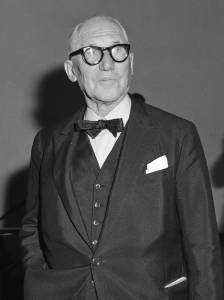
Before later changing his name, Jeanneret's contributions to Purism were influenced by his study at the German Werkbund from 1910-11. There he encountered the late Jugendstil ideas of Hermann Muthesius, who advocated for Typsierung, or typficiation, the use of standardized designs that would be both suited to modern mass production and reflect a uniquely German style. While studying at the Werkbund, he was also influenced by the work of Bruno Paul, who was then developing his Typenmöbel, or 'type furniture' where prefabricated units could be assembled to create various furniture items. Subsequently, Jeanneret apprenticed with Peter Behrens, who was the German electrical company AEG's artistic director and a pioneer of modernist and industrial design. Purism was informed by both the Werkbund's advocacy for the "total work of art" and design that applied to all the arts, urban planning, and architecture, and by Behrens' "machine aesthetic."
Après le Cubisme (1918)
In 1918 Ozenfant and Jeanneret wrote Après le Cubisme (After Cubism) for their first exhibition at the Galerie Thomas in Paris. The exhibition of twenty paintings by Ozenfant and ten by Jeanneret marked the public debut of the movement, while the publication critically defined it. Stating that, "The value of painting derives from the intrinsic qualities of plastic elements and not from their representational or narrative potential," the movement emphasized elemental types and pure forms, and opposed anything "accidental, exceptional, impressionistic, inorganic, contestatory, picturesque."
L'Esprit Nouveau (1920-25)
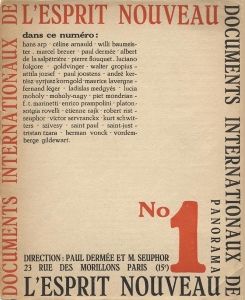
In 1920, the two artists launched the magazine L'Esprit Nouveau, which expressed their evolving theories, as their essay, "Sur la Plastique," appeared in the magazine's first issue. Discussing the phenomenological effects of form and color while employing an approach that emphasized logic, they defined a number of various categories including Primary Elements, Rhythm, Composition, Standards, Modules and Consequence. As historian Susan Ball wrote, "The most important factors were (1) the means by which to procure the sensation of mathematical and lyrical order, (2) the choice of subject - the 'Purist element' - and the development of this 'object-type,' and (3) the method for rendering the chosen elements." In publishing their articles, the two men used a number of individual pseudonyms and a collective pseudonym for collaborative efforts, which had the effect of suggesting a larger number of participants in the movement to lend it larger credibility. Both men believed that Purism was not only a theory of art, but of life. By 1923, Jeanneret had cemented this notion by changing his name permanently to Le Corbusier reflecting his new focus on architecture and his departure from painting. The name, ambiguously, came from the French word for raven.
The magazine also included illustrations of representative works, as well as articles on the sciences, transportation, music, and advertising for any number of products from household items to sporting goods. A number of leading thinkers, including the politician Victor Basch and the art critics Maurice Raynal and George Waldemar, contributed to the magazine's widening circles of influence. In 1920, Fernand Léger became close friends with both men as art historian Carol S. Eliel wrote, his "work increasingly reflected his assimilation of the Purist aesthetic." A second Purist exhibition, held in 1921 at the Galerie Druet in Paris further publicized the movement and the magazine.
Continuing the movement's outreach, in 1924 Ozenfant and Léger opened the Atelier Libre, or free Studio, in Paris where the artists Marie Laurencin and Aleksandra Ekster also taught. The magazine published twenty-eight issues before it ceased publication in 1925.
Pavillon de l'Esprit Nouveau (1925)

In Paris, in 1925, Le Corbusier built the Pavillon de l'Esprit Nouveau (Pavilion of the New Spirit) for the International Exposition of Decorative and Industrial Arts. The building embodied ideas the architect had expressed in a number of articles published from 1923-24 in L'Esprit Nouveau. As art historian Christopher Green noted, he "demanded a new anti-decorative, functional approach to interior design, according to which all furnishings and fittings were treated as 'tools' and nothing more, and they extended the 'type-object' idea to include all the most fundamentally useful, most formally Purist of modern, mass produced products." The building, a white cube, elevated on columns, or pilotis, with an atrium entry, included paintings by Le Corbusier, Ozenfant, Fernand Léger, and Juan Gris, and two of Jacques Lipchitz's sculptures. In conjunction with the Pavillon, Le Corbusier published his L'Esprit Nouveau articles as L'Art decorative d'aujourd'hui (The Decorative Art of Today) (1925), and he and Ozenfant published La Peinture modern (Modern Painting).
The building was both the synthesis and apotheosis of the movement, as it marked the last Purist collaboration. Le Corbusier designed the Villa la Rouche from 1922-1925 and became enraged at Ozenfant's hanging of the art, saying, "I insist absolutely that certain parts of the architecture should be entirely free of paintings." The quarrel caused a break in their collaboration, effectively ending Purism.
Concepts and Trends
Object Type
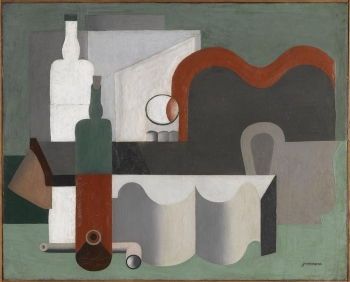
An important concept of Purism was the objet type, or object type, a standardized and reproducible object that included things such as drinking glasses, pipes, architectural components, and musical instruments like the guitar and violin. The object-type was viewed as a kind of building block for still life compositions. As art historian Stanislaus von Moos wrote, "objets types symbolize the virtues of the new industrial world: its order, its anonymity, and its purity - in short, its purism."
The term was intended to convey more than just a new approach to painting; it stood for the distinctive characteristics of modern thought. Seen in retrospect, it represents a synthesis of French enlightenment and German Werkbund pragmatism. In the Purist world, engineers occupy center stage...Haunted by the moral and aesthetic virtues of modern engineering, they develop a kind of rationalist cosmology in which nature functions as a machine whose adherence to physical laws is the very reason for its beauty." The Purists viewed these objet types as applicable to all the arts, and the concept became fundamental to Le Corbusier's architectural designs.
Painting
The still life was the primary subject for Ozenfant and Le Corbusier, as they composed images of a variety of ordinary objects, from kitchen plates, to scientific test tubes, arranged as volumetric and geometric forms. Fernand Léger's painting of the odalisque and the human form added a new subject matter to the movement, and his geometric and mechanized treatment transformed the figurative mode. Unlike the two founders who emphasized a kind of calm order, he interjected what he called "the law of contrasts" as he wrote in 1923, "I group contrary values together; flat surfaces opposed to modeled surfaces; volumetric figures opposed to the flat facades of houses; molded volumes of plumes of smoke opposed to the active surfaces of architecture; pure, flat tones opposed to gray, modulated tones or the reverse." Juan Gris' first solo exhibition at the Galerie de l'Effort moderne in 1919 led to his being dubbed the 'purest' of the Cubists, as he emphasized a geometric composition, where elements were flattened into a unifying plane, and he subsequently exhibited with the Purists.
Sculpture
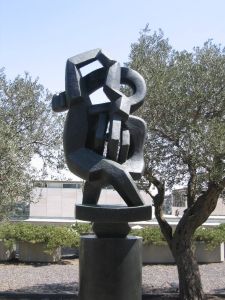
Jacques Lipchitz was the leading sculptor briefly associated with the Purists, as his sculptures were a notable aspect of the Pavillon de l'Esprit Nouveau. Around 1920 his Cubist works began to reflect the call of the "return to order," as they became based entirely upon geometric abstraction and emphasized an architectonic structure. He is thought to have influenced Le Corbusier's concepts of architectural design, as well as his later interest in sculpture in the 1930s. Additionally, Auguste Herbin's series Objets monumentaux (1918-20), which were painted assemblages on wood, carved into architectural motifs, including borders and garlands, blurred the boundaries between sculpture and painting.
Architecture
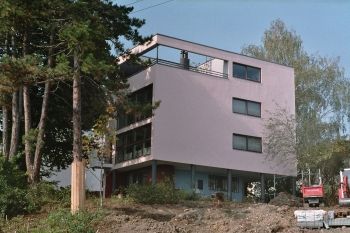
In 1923 Le Corbusier wrote, "The problem of the house is a problem of the epoch. The equilibrium of society today depends upon it. Architecture has for its first duty, in this period of renewal, that of bringing about a revision of values, a revision of the constituent elements of the house." Focusing on architecture, he translated the concept of the objet type to prefabricated components of which buildings could be constructed. He saw this new architecture, which he called the "House Machine," as connected to the "search for human scale, for human function."
One of his early designs the Domino House (1914) had already employed pre-fabricated components and the use of concrete. In 1920, he evolved these principles to design the Citrohan house, its name a play upon the French automobile company Citroën, as he emphasized "the absolute necessity of standardization" and argued that the house should be as efficient as a car. His ideas in modular units were applied to an entire city in his Villa Contemporaine design (1922). The principles he developed in his writing and practice were published in his L'Art décoratif d'aujourd'hui (The Decorative Art of Today) (1925) and became one of the leading tenets of modernist architecture.
Film
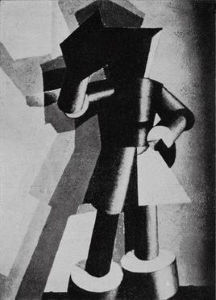
Purism's concept of the objet type not only influenced Léger's paintings but also his film Ballet mécanique (Mechanical Ballet) (1924). As he said of the film, "I thought that through film this neglected object would be able to assume its value...I took very ordinary objects that I transferred to the screen by giving them a very deliberate, very calculated mobility and rhythm." Interested in creating an art that was equivalent, rather than representative, of modern life, he wrote, "I have made use of the machine as others have used the nude body or the still life...The manufactured object is there, a polychrome absolute, clean and precise, beautiful in itself." The short film was composed of startling contrasts of repetitive human movements, fragmented images of the human body, juxtaposed with visuals and audio effects of mechanical motors and pistons. As he wrote, "You will see moving images presented like a picture, centered on the screen with a judicious range in the balance of still and moving parts (the contrast of effects); a still figure on a machine that is moving, a modulated hand in contrast to a geometric mass, circular forms, abstract forms, the interplay of curves and straight lines (contrast of lines), dazzling, wonderful, a moving geometry that astonishes you."
Later Developments - After Purism
Purism as a movement came to an end in 1925, though Léger's use of cylindrical forms would go on to influence sculpture as seen in the work of Henry Moore, as well as subsequent abstract painters.
Purism's primary impact was on architecture, as Le Corbusier became a leading architect of the 20th century. His designs and principles influenced architects throughout the world, and also informed the International Style and Brutalism.
Ozenfant's essays arguing for "color solidity" in architecture published in Architectural Review in the 1930s became a primary influence on the British Architectural Association. The architect David Medd adopted many of Ozenfant's tenets in his color standards, which were taught in art schools in Britain for the next two decades. Ozenfant was also influential as a teacher as he opened the Académie Ozenfant in 1932, followed by his 1936 move to London where his students at the Ozenfant Academy of Fine Arts included Hamed Saeed, Leonora Carrington, Stella Snead, and Sari Dienes.
 Ask The Art Story AI
Ask The Art Story AI








